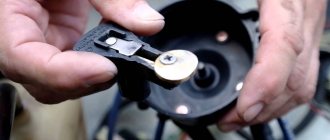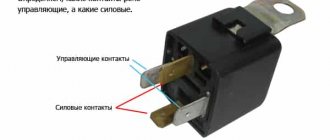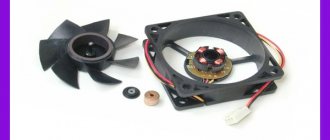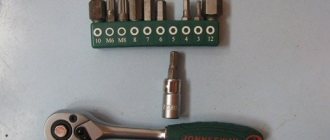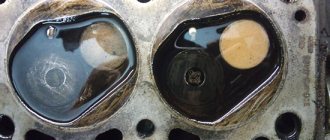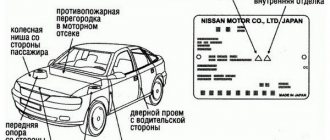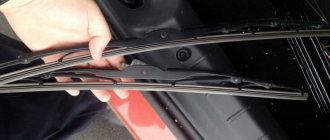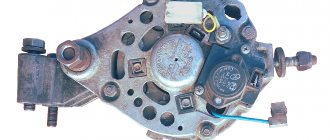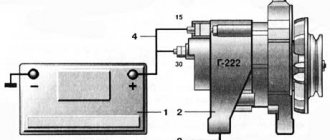Shock absorber malfunctions greatly influence the behavior of the car on the road. In particular, the car body “dives” during acceleration and braking, the braking distance increases, rolls heavily during maneuvering and sways when driving over uneven surfaces.
There are obvious and hidden signs of faulty shock absorbers. Obvious ones include the appearance of oil leaks (wear of the oil seal and/or rod), but there are more hidden ones, for example, aging of the oil, deformation of the valve mechanism plates, wear of the piston seal and the inner walls of the working cylinder. To avoid unpleasant consequences, you need to identify the faulty shock absorbers in time.
Inspect!
Cheap, reliable and practical. A visual inspection when diagnosing shock absorbers is a mandatory procedure. If you find a way to look at the shock absorbers, then at least traces of oil on the shock absorber body can be noticed immediately. To make sure the diagnosis is correct, just wipe the shock absorber with a rag and repeat the inspection after a few days. If the car is on a lift, then at the same time try to assess the condition of the shock absorber rods: they should sparkle! Traces of rust or other unsightliness are a sign of malfunction.
Tires can also tell you about problems with shock absorbers. Uneven wear patterns hint at a problem. It is also worth assessing the condition of the protective kits (anthers) and springs, then the upper supports. Well, ideally, and all other suspension elements. But here you need an experienced eye.
Unfortunately, a faulty shock absorber itself may not show external signs of wear. Its ineffective operation may be caused by wear of internal components and materials: this is impossible to calculate visually. In such cases, you should use other diagnostic methods, and also remember the actual period of its operation.
Signs of faulty shock absorbers
There are two types of signs that a shock absorber has completely or partially failed. The first type is visual. In particular, they can be identified by visual inspection of the shock absorber. The second type of signs includes changes in the behavior of the car in motion. Let us first list the signs related to the second type, since first of all it is necessary to pay attention to how the behavior of the machine has changed, in particular:
- Rocking when braking and accelerating . If the shock absorbers are working properly, then even with sharp braking the car should swing back no more than once, after which the shock absorber should dampen the oscillatory movements. If there are two or more swings, this is a symptom of partial or complete failure.
- Roll when maneuvering . Here the situation is similar; after exiting a sharp roll when entering a turn, the body should not sway in the transverse plane. If so, the shock absorber has similarly failed.
- Increased braking distance . This factor is due to the same swing during braking. That is, during prolonged braking, the shock absorber does not dampen vibration, and the car periodically lowers and raises the front part of the body. Because of this, the load on the front wheels is reduced, which reduces braking efficiency. The braking distance is especially longer for vehicles equipped with an anti-lock brake system. This is because the rear end rises and the ABS reduces the brake line pressure. Also, the braking distance increases when braking on uneven roads.
- The car does not “hold” the road . In particular, when the steering wheel is installed in a straight position, the car constantly pulls to the side. Accordingly, the driver must constantly steer in order to align the trajectory of movement.
- Discomfort when driving . It can manifest itself in different ways. In particular, some drivers and/or passengers feel discomfort from the rocking of the car when driving long distances; people suffering from “sea sickness” (the official name is kinetosis or motion sickness) can feel motion sick. This effect is a typical symptom of faulty rear shock absorbers.
Please note that signs such as long braking distances, uneven tire wear and constant need to steer may indicate other problems in the vehicle, such as worn brake pads, low brake fluid levels, uneven tire pressures, problems with the ball joint or other components. pendants. Therefore, it is advisable to perform a comprehensive diagnosis. Visual symptoms of shock absorber wear include:
- The appearance of drips along the body and stem. In particular, this occurs due to wear of the oil seal (seal) and/or shock absorber rod. A decrease in oil level leads to a decrease in the operating amplitude of the device, as well as to an increase in wear of the parts included in its design.
- Wear of silent blocks. As is known, in this rubber-metal hinge, mobility is ensured due to the elasticity of rubber (or polyurethane, depending on the design). Naturally, if the shock absorber works hard, then increased forces will be transferred to the silent block, which will lead to its significant wear and failure. Therefore, when diagnosing shock absorbers, it always makes sense to check the condition of the silent blocks.
- Damage to the shock absorber housing and/or its fasteners. This can be expressed in different ways. For example, the appearance of rust on the rod (stand, support), curvature of the body, damage to the mounting bolts, and so on. In any case, the shock absorber must be carefully inspected.
- Uneven tire wear. They usually wear more on the inside and less on the outside.
That is, if there is a malfunction of the shock absorbers, then expect failure of other suspension elements, because they are all interconnected and can be influenced by each other.
Rock it!
Not the most accurate, but the most popular and visual diagnostic method. You need to vigorously swing the front/rear part of the car, then remove the load and observe how quickly the body stops swaying. If, after removing the load, it performs more than one swing stroke, it means that the swing was not done in vain: the shock absorber, alas, is crappy... The only trouble is that in this way you can only determine a completely “dead” product, and even then with the proper experience. It’s another matter if the shock absorber is tightly jammed: this will be determined instantly, since it simply won’t be possible to rock the car.
Try not to overdo it when rocking, so as not to damage the body parts - this happens...
Let's sum it up
Taking into account the above information, it becomes clear that shock absorbers, especially on bad roads, require increased attention. It is recommended to carry out their scheduled inspection and diagnostics every 15-20 thousand km, as well as in case of unexpected appearance of the signs discussed above, indicating possible problems with the struts.
In this case, it is not necessary to immediately go to the stand to check the shock absorbers. As a rule, the methods discussed above allow you to quickly identify the problematic element. Finally, we note that, unfortunately, on CIS roads shock absorbers are considered a “consumable” item that has a very limited service life. In practice, this is true, since usually the racks last no more than 60 thousand km.
We also recommend reading the article about what can knock in the front suspension and how to determine the cause of the knock. From this article you will learn about the main malfunctions and breakdowns that lead to knocking in the front suspension of the car.
At the same time, the part is not the cheapest, and shock absorbers only need to be replaced in pairs on one axis. However, in the case of racks, you should not try to save money, since not only comfort, but also the overall safety of the driver, passengers and other road users directly depends on their condition.
For this reason, it is important to know how to quickly check shock absorbers in order to eliminate any irregularities, failures and deviations in the operation of the struts, as well as to localize the problem to the chassis in case of possible malfunctions.
Manage!
If, while driving, the car suddenly gains some independence - it yaws on uneven surfaces, sways in all directions, and reluctantly responds to the steering wheel, then most likely the shock absorbers are to blame. Contrary to popular belief, this manifests itself not only at high speeds, but even if the speedometer shows quite “urban” numbers. At the same time, there is no need to write a pretzel on the road - in a quiet place, exercises such as acceleration, braking, snaking are quite enough... In any case, if the car’s handling has deteriorated over time, you should contact competent specialists for diagnostics.
For example, you can see in this video how cars with working shock absorbers behave and those without.
:
When to change a shock absorber
It is necessary to understand that regardless of the quality of the shock absorber, as well as the operating conditions of the machine, wear of this unit occurs constantly. With more or less speed, but constantly! Accordingly, their condition also needs to be checked constantly. Most shock absorber manufacturers in the mid-price category recommend checking every 20...30 thousand kilometers . As for replacement, usually the shock absorber wears out significantly after approximately 80...100 thousand kilometers . At this stage, you need to check it more thoroughly and, if necessary, replace it.
To ensure that shock absorbers last as long as possible, follow these recommendations:
- Do not overload the machine . The manual for any vehicle directly states its maximum load capacity. You should not overload the car, because this is harmful to its various components - including the engine and suspension components, in particular shock absorbers.
- Let it get into working mode . When driving a car in the cold season (especially during significant frosts), try to drive the first 500...1000 meters at low speed and avoiding bumps. This will allow the oil to warm up and spread.
Thus, if problems arise with the shock absorbers, it is better not to tighten it and replace the problem units with new ones. As for the purchase, it is better to buy licensed shock absorbers from the “officials”. Or choose products in trusted stores based on reviews from car enthusiasts.
Try it on!
The simplest, fairly quick and not so expensive way to get general information about the effectiveness of the suspension is to stop by a diagnostic stand, take measurements and listen to the verdict.
Another question is how precisely the verdict will apply directly to shock absorbers. The fact is that in the case of various kinds of “shaking” (of which there are more and more recently), the presence of at least one faulty element (not necessarily a shock absorber) will significantly affect the final results of the efficiency indicator. In addition, the algorithms by which the performance of the suspension are assessed differ, and diagnostics of one car on different stands can lead to the fact that the data obtained on the condition of the suspension may differ.
Causes of shock absorber malfunction
The causes of failure are usually natural factors, including:
- Aging of shock-absorbing fluid (oil). Like other technological fluids in a car, the oil in the shock absorber gradually gains moisture and loses its performance properties. Naturally, this leads to the fact that the shock absorber begins to work harder than it worked before. However, it must be understood that fluid aging does not happen overnight, with the exception of a rupture of the seal on the shock absorber body.
- Torn seal. In particular, the sealing of the piston and the inner walls of the working cylinder. The oil seal can rupture due to external factors or simply due to the aging process. It, like any rubber seal, becomes tanned over time and begins to leak liquid. Because of this, oil leaks from the shock absorber, as well as moisture from the outside entering the oil, which leads to a deterioration in its performance.
- Deformation of the valve mechanism plates. This process is also natural and occurs on an ongoing basis, albeit at different speeds. Thus, the rate of deformation depends on two main factors - the quality of the shock absorber (the quality of the metal of the plates) and the operating conditions of the machine (naturally, a significant impact load leads to premature deformation).
- Gas leak. This is true for gas-filled shock absorbers. The idea here is the same as for oil-filled devices. Gas here performs a damping function, and if it is not there, then the shock absorber will not work.
- Failure of silent blocks. They wear out due to natural reasons, losing their elasticity and performance. These components are practically not subject to repair, so if they fail, they simply need to be replaced (if possible, or the shock absorbers must be completely changed).
Shockabsorber-replacement-14_
There are known cases when, when diagnosing a car on a “shaky ride” with a working suspension and recently replaced shock absorbers, the data obtained indicated low residual effectiveness of the suspension. But during the “test drive” the car behaved perfectly. The reason is that the stand was not designed for more “hard” settings of the tuning series shock absorbers compared to the characteristics of the original products, as a result - a wrong verdict. Well, that happens.
A very important point! The final indicators may be influenced by such parameters as tire pressure, vehicle loading during diagnostics, small deviations from a straight line when driving to the stand (appearance of a deviation angle from the longitudinal axis), accidental installation of the vehicle on the handbrake, uneven loading of the vehicle during diagnostics, etc. .d. It will be a real pleasure for a careless repairman to “cheat” a client out of the cost of new shock absorbers, so that in the meantime, as if by accident, pump up his flat tire...
Symptoms of wear
As you drive the car, the struts and shock absorbers gradually wear out. This directly affects handling, directional stability, and braking efficiency.
The problem manifests itself when driving with the following symptoms:
- increased braking distance, sharp forward lean when braking;
- the appearance of rolls, wheel displacement during turns;
- swaying to the sides when moving;
- vibration of the steering wheel when driving on a flat road;
- creaks, knocks, and other strange sounds from the suspension;
- liquid leaks on the racks;
- uneven pronounced wear of tire treads with pieces of rubber falling off;
- body tilting back during sudden acceleration.
If at least one or more of these signs appear, then the time has come for a more accurate diagnosis of the condition of the struts and the shock absorbers themselves.
Checking damping properties
This method consists of testing the performance of shock absorbers under calm conditions. Then the car is placed on a flat surface. Then one of its parts is vigorously swung with hands and checked to see how long it will take for the body to stop swinging.
The disadvantage of this method is that only completely “dead” shock can be controlled in this way. However, this is one of the fastest and cheapest (if not free) diagnostic methods. Another point: the shock absorber does not always “walk”. Sometimes the stem just gets jammed. In this case, the car cannot be rocked.
Why is it so important to monitor their condition?
The resource of this mechanism is about 60 thousand kilometers. This indicator largely depends on the condition of the road surface. The damper does not always supply this specified period. It can fail at any time. Therefore, it is necessary to be guided not by the regulations, but by the condition of these damping devices. Why is it so important to monitor your condition? A faulty shock absorber can cause wheel imbalance. As a result, tire wear will be uneven. The car will skid at speed. A faulty shock absorber will also shorten the life of the wheel bearings. They are quite expensive. But on many cars this unit is assembled with a hub. Thus, the cost of repairs can be up to 20 thousand rubles.
Check with removal
Dismantling will help you find out exactly which of the four shock absorbers is faulty. The removed element is installed vertically relative to the ground. How to check rear shock absorbers? Its lower bracket is fixed with feet. Hands take hold of the upper rod and pull it out, then press down. A working shock absorber has good resistance force. If the rod moves with one hand and not under tension, it means the element is faulty. There is not enough working fluid in it, or there is air inside (does not touch gas-filled elements). How to check front shock absorbers and struts? Diagnosis is made in the same way. These elements are arranged in the same way, therefore, if the rod moves freely, such a mechanism must be replaced.
Is it possible to drive on dead struts?
Is it possible to go
with a faulty shock absorber strut?
No, it needs to be repaired as quickly as possible
.
The shock absorber strut absorbs vibrations from the unsprung parts when the vehicle hits uneven road surfaces. towers
are critical to handling.
Interesting materials:
Why doesn't the flash alert work on my iPhone? Why did the flashlight stop working on my iPhone? Why doesn't the wheel wheel work on a wireless mouse? Why doesn't it work on YouTube yet? Why doesn't the Shift key work on my computer? Why doesn't wi-fi work on my Asus laptop? Why doesn't YouTube work on my laptop? Why doesn't the touch screen work on my tablet? Why doesn't video calling work on WhatsApp? Why does the Internet work poorly on Xiaomi?
Visual inspection
How to check the shock absorber for performance without removing it from the car? The cheapest and most practical way is to visually inspect the element. The shock absorbers are located next to the springs (sometimes they are assembled with them, like on a MacPherson strut suspension), behind the wheel. Take a look at their condition. There should be no oil marks or drips on the flasks.
Is it possible to drive if the shock absorber is leaking?
The question is actively discussed on automobile forums: “A shock absorber has leaked - is it safe to drive?” We already wrote above that you can still drive a car with a leaking shock absorber for some time, but soon it will “die” anyway.
Many would-be drivers drive with damaged shock absorbers until the car's chassis completely falls apart. Such driving is dangerous and ruinous due to a number of possible consequences.
- A wheel bouncing randomly on bumps constantly loses contact with the road. If you find yourself on an uneven section of the roadway with faulty shock absorbers, you can easily fly off the road into a ditch.
- The lack of damping significantly increases the braking distance. When braking, a car with inoperative shock absorbers sharply shifts the center of gravity to the front wheels, dangerously unloading the rear - this can lead to loss of stability when turning.
- Unusable shock absorbers have an extremely negative impact on the operation of the anti-lock braking system: the brake pedal crushes under your foot, and the car does not want to slow down on the road. The result is sometimes very disastrous.
- The wear and tear of all the joints and components of the chassis also looks depressing. Due to severe suspension breakdowns, the rubber compression buffer very often falls apart and the shock absorber rod bends. Silent blocks, ball joints, and levers all suffer - if the shock absorber does not withstand the impact, then they are subject to exorbitant loads.
Judge for yourself: either the entire suspension structure will absorb the shock at one time, evenly distributing the impact energy, or the bunch of parts will convulse several times as the car passes over each bump.
Therefore, if the stability of the car deteriorates, if the suspension frequently engages all the way, and even more so when knocking appears on uneven surfaces, immediately check the chassis and replace worn shock absorbers.
It should be recognized that, unfortunately, shock absorbers on our roads are consumables that rarely withstand more than 50-60 thousand km. mileage Therefore, our advice is never to skimp on traffic safety!
What are the benefits?
The advantage of checking this method is the high accuracy of fault determination in a short period of time. In addition, truck owners cannot do without such a service. After all, it is unlikely that you will be able to rock such a car with your hands (as in the second method). The vibration stand allows you to identify the problem in a complex manner. The only negative is the low prevalence of such stands throughout the city. And the price is not always acceptable.
So, we found out how to check the shock absorber for serviceability in various ways.
How to check it yourself
Very often, drivers resort to modern technologies, such as vibration stands, to check. But it often happens that you have to carry out diagnostics without such equipment, using only your own abilities and available materials. And for those who do not know how to check shock absorbers, I will tell you a rough plan of action.
The first step is to do a thorough inspection of these elements. This approach will allow you to identify obvious symptoms and possible malfunctions of the racks . For example, if during inspection you find that there are oil stains on the walls, then you should think about replacing the sealing elements, otherwise the shock absorber will become unsuitable for use, since running this mechanism “dry” will provoke rapid overheating and sudden wear of all elements receiving active participation in the work of racks. And most importantly, you will feel it yourself, with your butt.
The next thing you need to do is analyze the operation of the suspension, listen to see if there are any additional, unpleasant noises during its operation. If, when diagnosing the suspended part, you did not find any signs of failure, then you should safely assume that the knocking is occurring precisely because of faulty racks.
Diagnostics can also be carried out by rocking the car. What will this method do? If, when rocking, the car moves freely from side to side, then this is a clear sign of a malfunction of the struts. Given their excellent condition, it will be quite difficult for you to make the car sway. Since the main task of the racks is to dampen vibrations, if they work properly, the car will instantly level out and quickly return to a stationary position.
The last thing you can do to check the quality of the struts is to compare them with the work of another vehicle. You need to experiment with this at least once a month. Of course, this option may not bring a positive result, since the struts of another car may also be faulty, so you will not feel much of a difference. But sometimes this option can help you understand the difference between the performance of your shock absorbers and another vehicle.
Vibration stand
It is not always possible to determine a breakdown without removing the element. However, there is a way that allows you to find out the problem at a professional level. How to check shock absorber struts without dismantling them? To do this, the car is driven onto a vibration stand. The cost of the service starts from 1 thousand rubles. At the same time, not only shock absorbers are checked, but also other suspension components, as well as the braking system. The vibration stand simulates road irregularities, allowing you to accurately determine the malfunction of a particular mechanism. The lateral rolling of the car is also checked (this way you can find out the serviceability of wheel bearings and ball bearings).
Method of checking while driving
Some driving experience will be required to determine the malfunction while on the road. This will be indicated by the presence of excessively strong rolls, and a slow response to steering turns, along with active rocking across and along the body part.
The fault lies in the rack when:
- Even a slight unevenness of the road surface causes a vehicle to “yaw” when driving;
- The car body shakes not only longitudinally during the trip, but also in the transverse direction;
- When braking occurs, the car makes certain “pecks”, which is very noticeable and strongly felt;
- A small tapping sound can be heard quite clearly when driving on an uneven surface. Moreover, this happens alternately, now in one wheel, then in the other;
- There is no pleasant sharpness in the process of steering, along with the clarity of the machine’s perception of the driver’s commands;
- Wheel traction on surfaces where there are uneven surfaces is insufficient, that is, the car behaves poorly when braking.
When checking the shock absorbers while driving has already been completed, it is possible to determine in a fairly simple way the degree of their heating, since during operation the shock absorbers become hot.
You can determine which shock absorber is faulty by hand. It is the one that remains almost cold and will require appropriate replacement.
